By N. Niranjan Nikam
The Heritage City Mysuru is known for its Palaces and Stately public buildings. One such building is the Devaraja Market, which has captured the hearts of people of the city and the world for its design, planning and aesthetics. However, the authorities are thinking of bringing down this 130-year-old building and put up a new structure in its place.
The picture above shows the remnants of the structure of the North Gate which was demolished in August 2016. The picture below (aerial view) presents a sad tale of how the North-end of the market is covered with asbestos sheets and lying in neglect since the last two years.
This Weekend Star Supplement brings to the readers in detail the diabolical way the North-end of the Market was brought down.
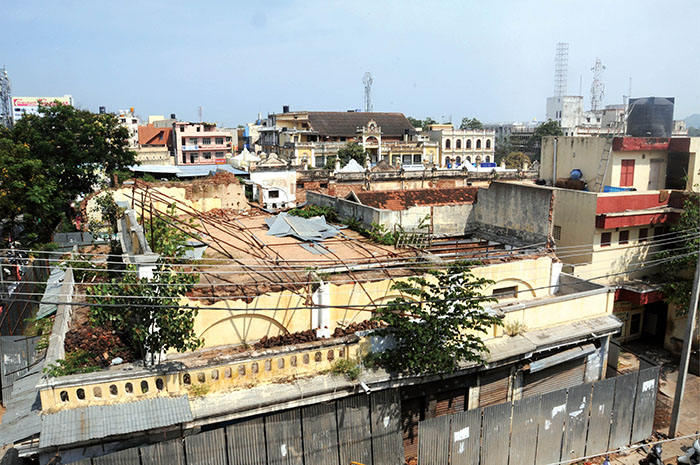
Demolition of Devaraja Market North Gate: The Untold Story
The 130-year-old Devaraja Market, the hub of Mysuru City, is a place very close to my heart, as I spent the better part of my life there. My father ran a handicraft business at the North Entrance of the Market for nearly 35 years and later withdrew from business.
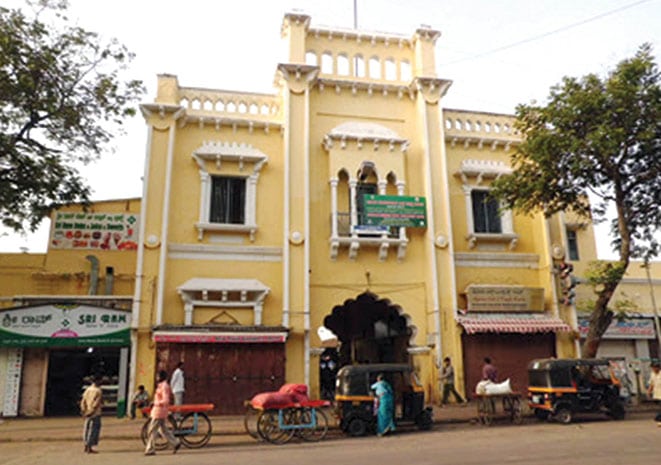
The architecturally designed majestic entrance to the North-end of Devaraja Market before it was demolished.
August 28, 2016, 5.30 pm, is a black letter day in the history of the city as the North Gate Entrance of the Market collapsed. It is two years now and the whole place stands as an ugly testimony to the callous and negligent act of the Mysuru City Corporation (MCC).
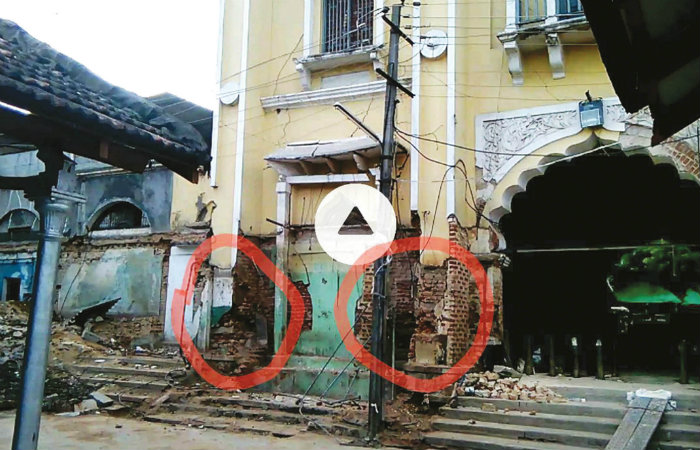
The inside entrance of the North-end where the circle marked shows the preparation for demolishing the place.
It was ages since I walked into the Market from the North-end. But when I did, I always experienced not only nostalgia but pain looking at the entrance covered with asbestos sheets.
One day, I decided to walk down the memory lane, and as I climbed down the steps to enter the Market, the first person I encountered was Srinivas, who sells all varieties of greens (soppu). I casually introduced myself to him and even before I could mention who I was, he immediately said, “Sir, I know who you are. You had that handicraft shop at the gate entrance which you gave it away to someone else.”
I asked him about the collapse of the building and he said that his brother Naveen knew much about it as he was a witness on the day the North-end collapsed. Slowly, the truth about the collapse unfolded.

The bulldozer bringing down the shops on North Entrance of Dhanvanthri Road.
Both Naveen and another boy Bharath whispered to me, “Sir, it was a Sunday evening. We were all suddenly asked to leave the place. Then the drilling machines were brought in and at around 5.30 pm, the building came down. It was demolished and it did not come down on its own because the building was weak,” they said.
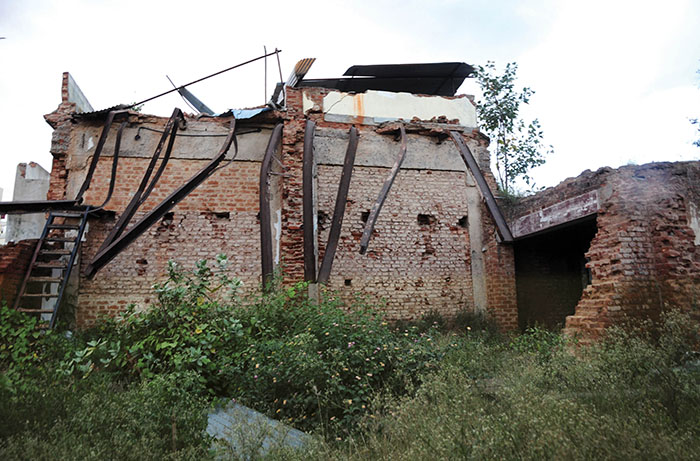
Weeds have grown since the last two years in the place where the shops were demolished. The strong iron beams can be seen hanging.
The place looked like ruins right in the heart of the city and it has been lying in this neglected state for the last two years. Then it was the turn of another young man, who runs a vegetable shop, to share his woe. He was doing his business sitting outside the shop as his shop was partially damaged. Pointing to the iron scaffolding inside the shop, Murthy said that the MCC authorities had promised to repair his shop and give it back to him. “They have put this scaffolding a long time ago, but no repair work has happened. I am forced to sit on the pavement to do my business,” lamented Murthy.
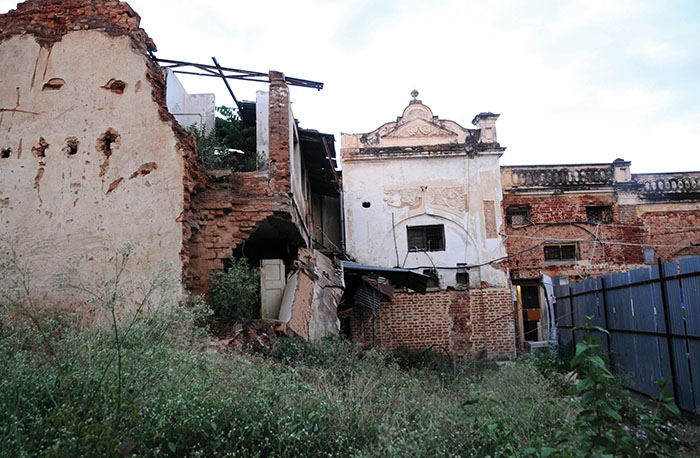
A similar scene on the left side of the entrance to the North-end shows the sorry state of neglect by the Mysuru City Corporation.
Devaraja Market Tenants Association
If there is one person’s name that is on the lips of every trader in Devaraja Market, it is S. Mahadev, President, Tenants Association of Devaraja Market.
A pailwan, Mahadev, runs a puja articles shop, Suputra Traders, inside Devaraja Market, has a typical wrestler’s instinct and it is only because of his constant intervention and fighting abilities that the lives of nearly 10,000 people, dependent on the Market directly and indirectly, are still continuing, even though a Damocles Sword hangs on them.
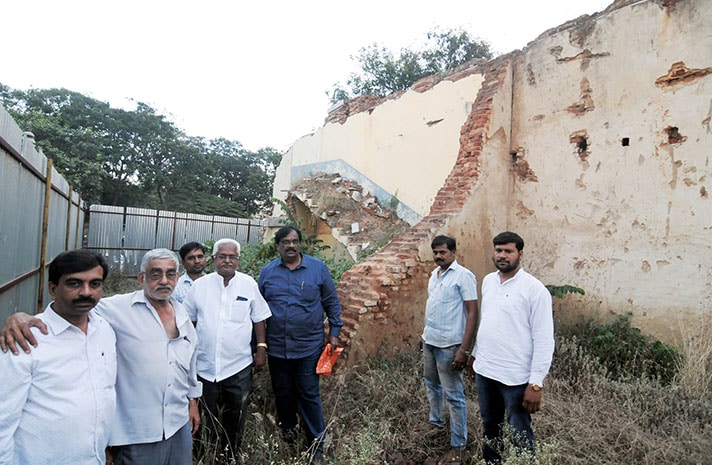
The members of Devaraja Market Tenants Association seen with President S. Mahadev (third from left) at the site.
Recalling the dark day, August 28, 2016, Mahadev alleged that the MCC had played a diabolical role in bringing down the North Gate of the Market. “It was a conspiracy by the elected representatives and MCC officials to somehow demolish the heritage structure and build a new multi-storey in its place. The motive was not to preserve and conserve the history of the place but to put up ugly structures and as usual line their pockets,” he said.
How did he manage to prevent further catastrophe?
“The day after the collapse, the MCC brought JCBs and demolished the remaining front portion of the Market citing structural weakness of the building. But all along, we knew that the foundation was strong and the bricks and mortar could sustain with proper maintenance,” he said.
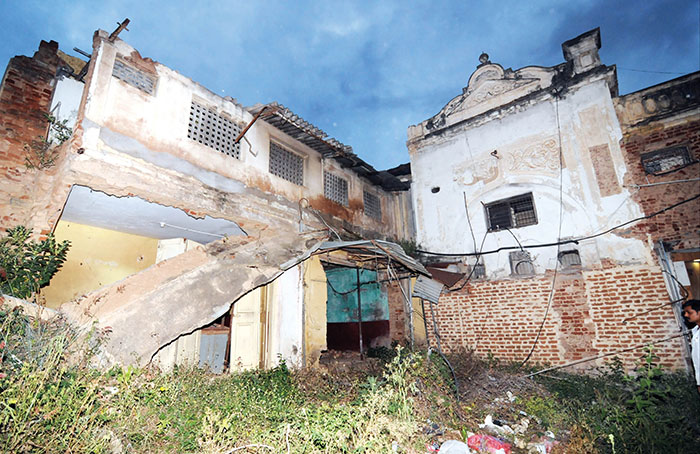
A view of the place with exposed bricks & crumbling chajjas.
What did he do then?
“Even as they planned to bring down the whole Devaraja Market, as they had already issued notices to the tenants and given them seven days’ time to vacate, I called for an emergency meeting of the tenants and asked all of them to approach the High Court for a stay as this was a heritage building and under the Heritage Act, it cannot be destroyed. Then, armed with their petitions, I along with a few of the Executive Committee members, including L. Mukesh Chug, a tenant and a Committee Member, quietly slipped away to Bengaluru and got in touch with a High Court Advocate B.S. Nagaraj,” he said.
The matter came up for hearing and the MCC authorities claimed that Devaraja Market was not a heritage building. But Mahadev had already collected evidence by applying for information about the Market under Right To Information (RTI) Act, right from 2005-06 itself, and he had also collected documents from Mysuru Urban Development Authority (MUDA) declaring Devaraja Market as protected heritage building.
“The moment we produced these two evidences, the High Court immediately gave us a stay order to stop the demolition in January 2017,” he said. Nearly 100 tenants including Bata India had gone in an appeal to the High Court which gave a stay in favour of the petitioners. [A copy of which is available with Star of Mysore].
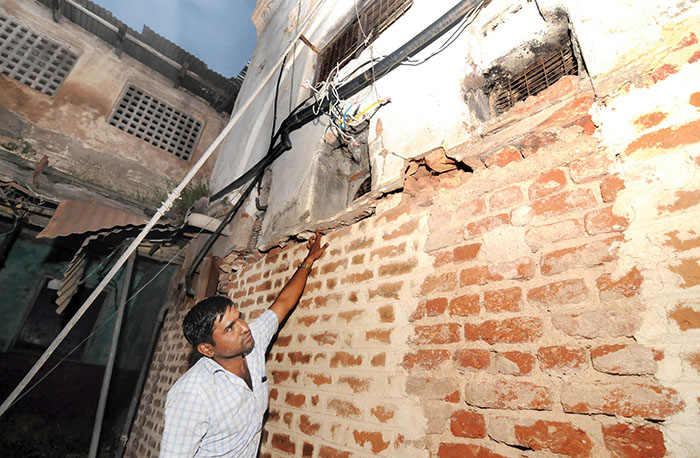
A shop tenant showing exposed electric wires which lie unattended.
MCC fails to follow Court order
Meanwhile, one of the affected tenants, the late N.S. Sathyanarayana Rao’s wife N.S. Satyavathi filed a case in the Mysore City Judicial Magistrate Court telling that the shop “Sri Rama Bakes and Sweets,” facing Dhanvanthri Road, which her husband ran and which she continued after his death, had been demolished.
She requested the MCC to rebuild the structure at their cost. However, in spite of her repeated appeals, the MCC continued to ignore her request following which she filed a case in Mysore Court.
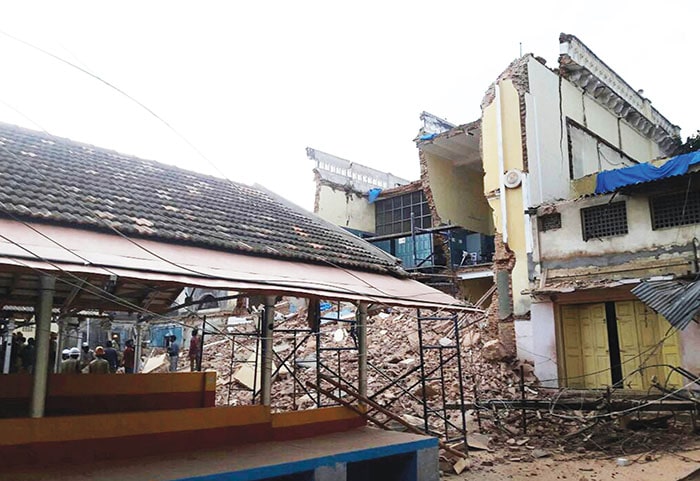
This was the scene on the day two years ago when the North Entrance Gate was being brought down.
The Court, in its Order dated February 3, 2018 [a copy of which is with Star of Mysore], states that since the tenancy of Satyavathi had not been terminated by the MCC (which is the defendant), and she continues to be the tenant, it has to rebuild the shop.
The Court clearly stated in the Order, “The defendant Authority is hereby directed to rebuild the shop in the suit schedule premises and to hand over the possession of the same to the plaintiff within 6 months from the date of this Order.”
It is more than six months now and the MCC has continued to ignore the Court Order. The slow-arm tactics of the government has continued to throttle the lives of the people.
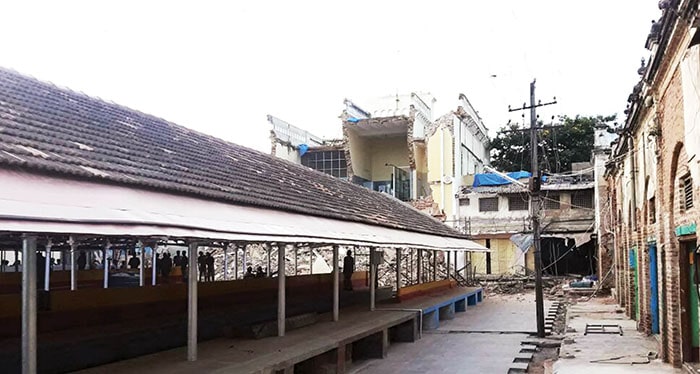
Another scene where all the shopkeepers were asked to leave the place that evening before the demolition of the structure.
Conflicting Reports of Experts
There are two Reports on the collapse of Devaraja Market and whether it should be preserved or demolished and rebuilt.
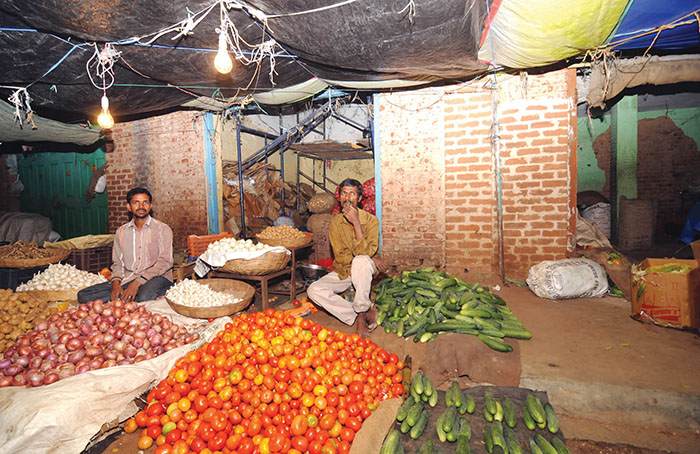
Two of the shopkeepers who are forced to sit outside to sell their vegetables as the shops (in the background) they run are lying in a dilapidated state.
First Report
The First Report is by the “Government of Karnataka Task Force For Quality Assurance in Public Constructions — Report of Task Force for Quality Assurance on Devaraja Market collapse at Mysuru” in October 2016.
Even as the building collapsed in August, the State Government set up a Task Force headed by Chairman Prof. B.R. Sreenivasa Murthy and consisting of Prof. R. Jagadish, C.N. Babu (now late) and Prof. Syed Shakeeb ur Rahaman, which came out with a report after a complete study of the issues.
In its Report, the Task Force said, “The Task Force team and SJCE Professors team recommend dismantling the entire structure and reconstruct the Market retaining the original heritage structure.”
It went on to add, “It proposed to construct a multi-storied market complex with at least one basement floor exclusively for parking, keeping the original heritage features.” To buttress their Report, they even quoted the decision of the Heritage Improvements and Restoration Committee on Devaraja Market.
The Task Force Report stated, “In the Heritage Improvements and Restoration Committee (HIRC) meeting held on January 10, 2006, which was attended
by Ravindra Gundu Rao, Maj. Gen. S.G. Vombatkere (retd.), Prof. Daroga, Dr. H.A.B. Parpia (late), Dr. M.S. Nagaraja Rao (late) and Dr. N.S. Rangaraju, a decision was taken to dismantle the heritage structure.”
However, Dr. Rangaraju, a member of HIRC, speaking to Star of Mysore, clearly said, “We were completely unaware of our approval for the dismantling of the heritage structure. We in fact were never invited to inspect the Market and hence the question of us recommending anything does not arise at all.”
Dr. Rangaraju also said that the Devaraja Market can be restored to its lost glory just like Dr. S. Radhakrishnan Bungalow and Jayalakshmi Vilas Mansion belonging to the University of Mysore, as he himself was involved in the restoration work of both these buildings.
Second Report
Looking at this allegedly biased Report, Devaraja Market Tenants Association President Mahadev frantically looked for an expert who could give an unbiased and correct report. After searching for sometime, he found the young and no-nonsense expert Dr. Arun Menon, Assistant Professor, Structural Engineering Laboratory, Department of Civil Engineering, IIT Madras, Chennai, and Convenor, National Centre for Safety of Heritage Structures (NCSHS).
Dr. Menon came all the way from Chennai on an invitation from Mahadev and after participating in a seminar at the Jaganmohan Palace and studying the Devaraja Market, gave a report titled, “Structural Review of Heritage Buildings in Mysore, Karnataka — Case Study of Devaraja Market and Lansdowne Building.” This Report was commissioned by the Tenants Association of Devaraja Market and Lansdowne Building. The exhaustive, almost 75-page report, clearly states in its introduction’s first para itself, “Requesting authorities TO NOT DEMOLISH OUR ‘PROTECTED HERITAGE BUILDINGS’ without due diligence of undertaking structural assessment study and deliberations with all stakeholders.”
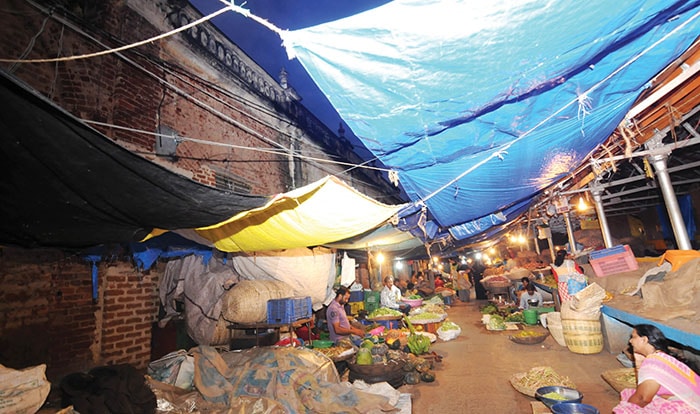
A view of the shops on the left side which the MCC had promised to restore to its original state two years back.
Preserve Devaraja Market at any cost
Should the 822 shops of all kinds and sizes, which pay monthly rents and 300 shops which pay daily fees in the Devaraja Market, spread over 3.67 acres, be demolished or conserved? This is a question that is facing the tenants and the people of the city with the MCC trying to find devious means to annihilate the 130-year-old, one of its kind Markets in the country.
Academician and Architect, Prof. H.D. Nagesh, Principal, Wadiyar Centre for Architecture, strongly feels that the Market should be preserved at any cost. “The design of the typical character of a Market was influenced by the Britishers and even the Maharajas of Mysore followed this idea. Hence, we see the more formal rows of shops outside the Market facing the main roads while the informal shandy atmosphere prevails inside,” he said.
According to Prof. Nagesh, the Market should be retained as the relationship between the Market and the people have developed over a period of time and there is an emotional connection. Even for the students of architecture, design and other disciplines, there is so much to learn from the history and heritage of such buildings. Hence, if it is not conserved, then there will be no connection with the past and as a result we lose a standing example of heritage.
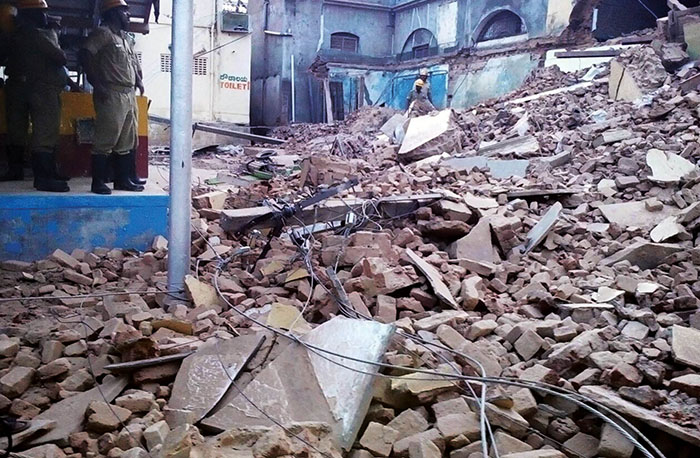
Firemen standing alert even as the demolition is taking place.
Maintain Heritage Design
Devaraja Market Building and Lansdowne Building are protected heritage structures of Mysore, Karnataka, and all national and international regulations and guidelines apply. Any destruction to protected heritage property is against the international norms of conservation given by UNESCO of which India is a signatory.
The introduction concludes, “Given that the building has been in continuous use for the past 125 years by the locals and they form the intangible cultural heritage of Mysore. Also that sentiments of several million Mysureans across the world is attached to the buildings. Any decision must be taken in consultation with the stakeholders and public participation. Otherwise, it will be considered as a unilateral decision taken by and for vested interests and ulterior motives.”
Dr. Menon points out to MUDA’s proposal to constitute a Special Heritage Committee in which the members are Deputy Commissioner, Mysuru; Corporation Commissioner; Chief Officer, Nanjangud TMC; Deputy Director, Department of Archaeology, Museums and Heritage; Town Planning Member, MUDA; one nominated Architect/UD/Urban Planner with experience of 10 years in Urban Design and Structural Engineer and scathingly comments, “This list of professions does not include any person who is professional in the field of conservation, history, etc. This list should be expanded to include experts in fields like: Archaeologist, Conservation Architect, Anthropologist, Historian, Art Historian and others.” However, both the Reports have not taken into consideration the eye-witness accounts of the tenants who clearly state that the Northern-end of the building was deliberately brought down and it did not collapse on its own.
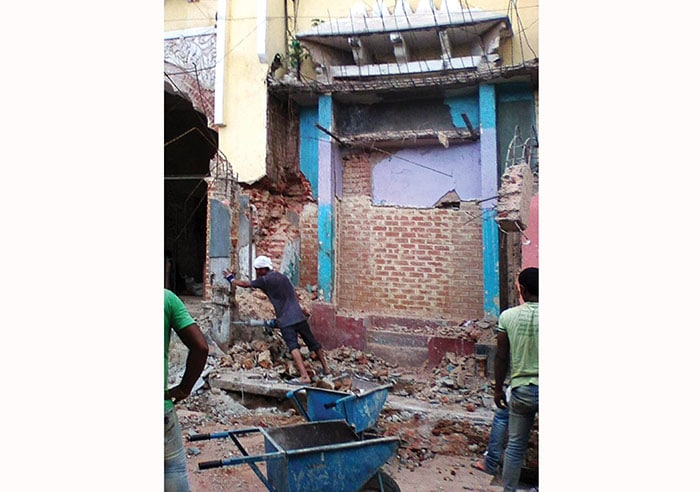
A worker using drilling machine to bring the place down.
IHCN’s role
The Indian Heritage Cities Network (IHCN), which is tasked with the preservation of heritage structures, it is learnt, was also approached by the MCC for its expertise. However, sadly, though its presence is very much there in Mysuru, it did not play any role in saving the North-part from destruction.
“It was the bounden duty of the IHCN to take all measures to stop such destructive moves of the civic body. They are also paid a handsome fee for their consultancy by the MCC. In spite of all this to completely ignore the destruction was nothing short of sacrilege,” said an expert who was in the know of issues.
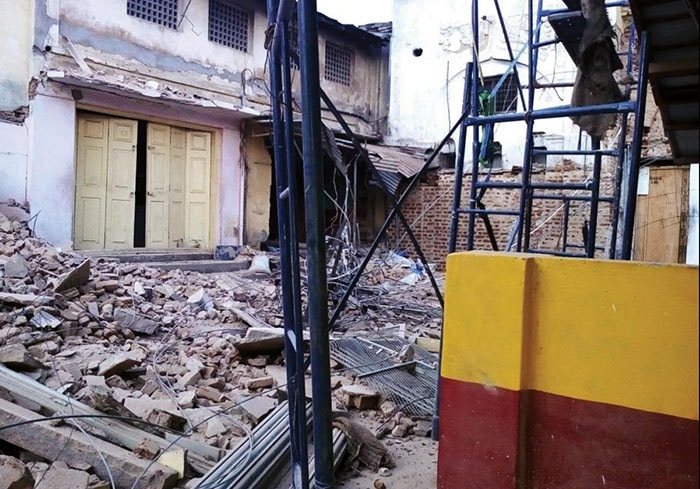
Rubble seen lying around after the demolition.
Destination Devaraja Market: A Brief History
There is no clear documentary evidence on when exactly the Devaraja Market was built and hence some of the historians point to the time when Viceroy Lord Dufferin visited Mysore and in his name the Dufferin Clock Tower (Chikka Gadiyara) came up in the late 1880s by the time which the Market had already existed. Before the Market was built, there was a regular santhe or shandy happening here and the villagers from surrounding areas would come with their wares to sell. It is also said that it is built on a canal.
The Market is unique in many respects as this is considered one of the first super markets in the country with everything available from pins to groceries, fruits, vegetables and all other household items under one roof.
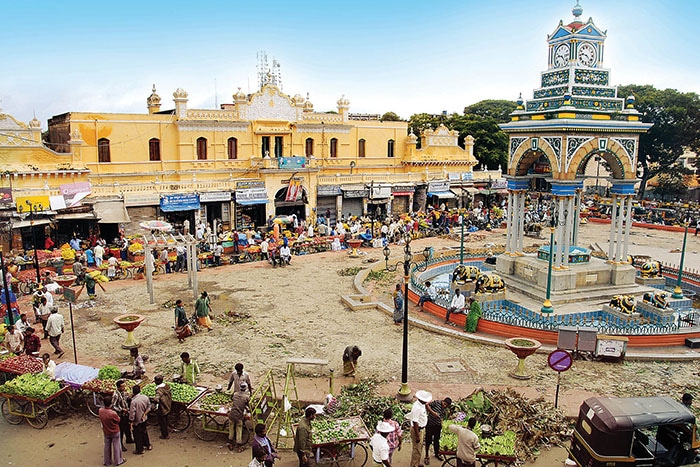
The Market is also the melting pot of all castes, creed, religion who have co-existed in perfect harmony for more than 100 years. This is also the place where one can see gender equality with women playing a big role, thus proving that Mysuru women had been empowered long ago.
In spite of the ravages of time and the destruction that has occurred, the Devaraja Market has not lost its lustre, as people continue to throng the Market from all over the world and on festival days including the just-concluded Dasara season, it is still the preferred destination.
Note
There are a few iconic heritage public buildings in Mysuru over 100 years old that are very badly maintained and subjected to total neglect and even vandalised. Some of these buildings need to be demolished and rebuilt maintaining the heritage architectural design in order to preserve and protect this Royal City’s heritage status. Maybe one or two could be preserved as they are after restoration work and by strengthening of the buildings.
We remember, sometime around the year 1985-86, a proposal was made to demolish the present Deputy Commissioner’s Office which is considered as one of the most unique heritage buildings as far as its architectural design is concerned.
Fortunately, due to vehement opposition by Indian National Trust for Art and Cultural Heritage (INTACH) of which the late senior journalist Krishna Vattam was a Member-Convener, the idea of demolishing it was dropped with the suggestion a new Deputy Commissioner’s Office be constructed while keeping this as a monument or a heritage building by restoring it. It was suggested that it could be used for any purpose where human footfalls would be minimal. The wiser counsel seems to have prevailed with a new Deputy Commissioner’s Office coming up on Malai Mahadeshwara Road in Siddarthanagar while the present building would be a protected monument, hopefully.
In a similar manner, talks were going on to preserve and protect the Devaraja Market building as a heritage structure simultaneously continuing to use it as a market place that it has always been and meant to be.
Those who have seen this building and also the appurtenant structures for the last 70-80 years would vouch that the original tenants numbering over 1,100 have not been conforming to the terms and conditions under which they were allotted the shops. Many of the shops have changed hands either by way of sub-lease or benami sale with or without the help of some of the unscrupulous officials of the Mysuru City Corporation (MCC).
Same could be said of another iconic heritage building, also a shopping hub Lansdowne Building at K.R. Circle. Both these buildings had covered shop fronts in the form of a long corridor intended to provide shelter to the shoppers from rain and shine. Unfortunately, this corridor has been swallowed by the shopkeepers themselves and it could be with connivance or formal approval from the Corporation.
Now the question simply is: Whether Devaraja Market building is structurally weak and dilapidated that it should be demolished or not. If the building is strong enough to last long with restoration work, then don’t demolish.
Surprisingly, the Task Force mentioned in the article does not give either of the two opinions mentioned above in a firm and definite manner. It has to tell the Corporation in definite terms either to demolish the present structure or to undertake restoration work. This is a strange report that has given room for both litigation and politics.
It is a Market built about 130 years ago for the then population. Now, times have changed and the population has increased to 11 lakh plus. Though there are Markets in different Layouts, they are no match to the size and also the variety of products available at Devaraja Market. Therefore, in a such huge area of 3.5 acres available in the heart of the city, it is advisable to demolish the present structure and in its place a new market building with underground and also one or two floors, in compliance with the law in this regard, would be the best option according to a couple of architects whom this paper had consulted.
The original architectural design may, however, be adopted to the new building to make it look like a heritage building though rebuilt. Otherwise, with the kind of rainfall we are getting these days, we won’t be surprised if the whole building collapses, God forbid, making headline news in newspapers and TV. We the Mysureans are warned. – K.B. Ganapathy, Editor-in-Chief



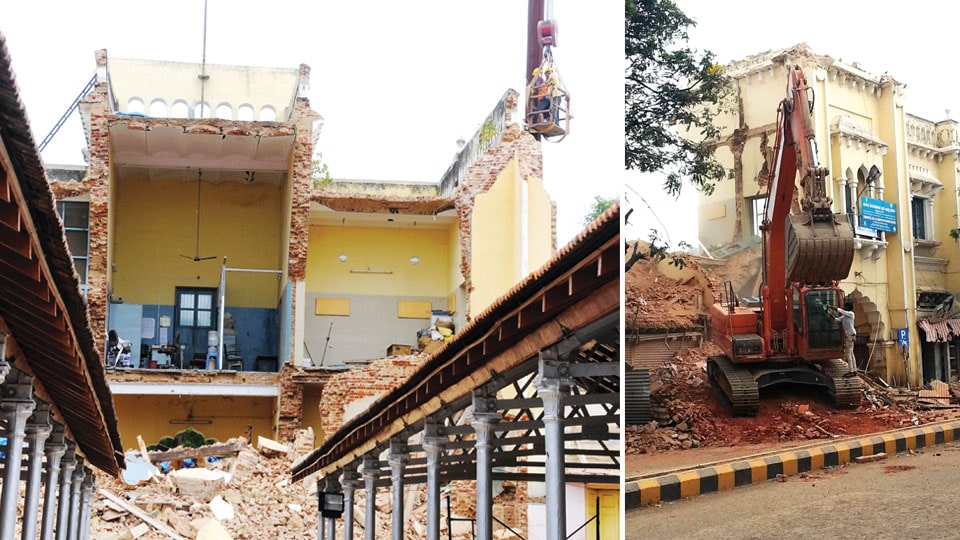




The author uses the term :”iconic” several times referring to buildings . He should first examine, whether, Mysuru as seen today, is the iconic Mysore we all knew in 1950s and even 1960s, where it was a tranquil abode, with people walking on footpaths to go to work; cycles were used as means of transport to a distant; the perimeter of this city was compact, which made the City , a serene Royal City with the Palace at its centre. Pollution was unheard of. One could listen to the roar of the tiger in the zoo in the early morning, no matter where one lived in the City, which was singularly quiet in the morning.. Articles written recently in this paper suggested that the City has become another Bengaluru with all the maladies that go with it.
When the iconic state of a city is obliterated through uncontrolled population growth and hence expansion, the negative outs ensue from there. Lansdowne building for example was falling apart in early 1960s, because of poor upkeep and maintenance. The frontal corridors of shops there were populated with job typists and others, which meant that the shops at the back, did not do much business. There were a few second hand book shops in front of the building which did business. But they folded out too. The main shops there ,one by one closed as the owners retired or sadly passed away, with heir entrances boarded up. The building was in effect slowly lost its ascetic value.
As for The Devaraja Market ,It was constructed to serve the Mysuru of early 20th Century, a city of very modest size. But as the City grew in size, a central market became a distant market for new housing postcodes.
We noticed as far back as in early 1960s, the fruit shops there for example, were sublet many times over so that no one knew who the owners are. As owners changed fast, they lost the usual customers The same situation with the vegetable market at the back. This market became less and less of destination for Mysuru shoppers.
Local places like Nanjumalige, then was the preferred destination for vegetables and fruits, with vendors bring them fresh every day from nearby villages.
Mysuru has lost its iconic status and so are the buildings mentioned in the article. No surprise at all.
Correction: Should be : ” negative fall outs..”
The Mysore I knew as a boy, was a nice and beautiful place to live. There were “iconic” commercial and residential buildings with unique architecture. Some of the houses were really beautiful with wonderful names. As the above letter states, the place was peaceful and the people were kind.
Over the years, corruption, neglect, and incompetence of the city administration has resulted in the haphazard growth of commercial buildings, apartment complexes destroying many classic buildings. The way things are going, Mysuru will be a heritages city in name only.
I cry for my beloved Mysuru!
Those days of past, Bangaloreans used to laugh at Mysoreans asking how can any one live in such a peaceful city, and take life with a measured sense of calmness, without understanding that the standard of life in Mysore was that much superior, in a City which did not experience the growing pains of Bangalore. Although, many in Mysore were angry when the Akashvani was relocated to Bangalore by Kengal Hanumanthiah, then CM, arguing that Bangalore was the Capital City of the then Mysore state. It was a blessing actually, as that City experienced galloping uncontrolled growth.
Agree that successive incompetent city administration did not help, but then they were under orders from the State government of politicians who never appreciated the unique place of Mysore in the history of the State. Mysoreans too did not agitate for recognition of this City as a Heritage Place, given the rich history of Wadiyars, who made the place their abode after the defeat of Tippu Sultan.
Yes, weeping for beloved Mysuru is the only option left!
In our opinion Devaraja Market is not iconic unlike the Dufferin Clock Tower opposite with its connection to Maharaja Chamaraja Wadiyar, who received the then Viceroy Lord Dufferin, and erected this beautiful clock tower to commemorate this visit in 1886. Hence, it is appropriate to append the heritage status to it. As for the Lansdowne building, as a poster put it above, the structure was already in a state of dilapidation even in 1960s, as its purpose was fast disappearing.
Devaraja Market made sense in Mysuru of the early half of 20th Century, when people after their office day came for their vegetable and fruit shopping. Then, even residential extensions like Yadavagiri and Saraswathypuram did not spread much, and hence, the Market was reachable by foot or with a just few stops in the bus. That is to say that Mysuru was a modest size city then, with its density of population at the lower end of the scale, just like the population situation in India then.
Looking at Mysuru of 2018 with its ever growing population and more residential extensions coming up in greater Mysuru for miles from this Market, with local markets springing up, this Market building cannot function as it did before. At best, it is sensible to renovate and maintain its frontal architecture to remind Mysorean of today, its importance in a bygone era. It makes sense to encourage the expansion of local markets in residential layouts, where the residents there could shop within a walking distance.